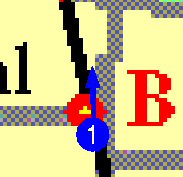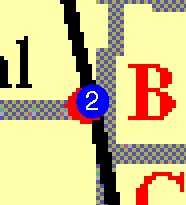

The fault evidently aspires to be law-abiding, and so after offsetting the far curb (the photo on the right, B2, shows a close up of that) it carefully crosses the street using the crosswalk. (The front yard of 608 Central is visible in the background of this photo.) Graffiti in the cement of the curb indicates it was poured in 1975; the close-up photo of the curb was taken 16 years later.
Notice the interesting way the displacement is damaging the street: instead of a single continuous break there are many short ones, all parallel and diagonally staggered like the shingles on a roof. This style of faulting is called ``en echelon'', and occurs on scales from microscopic to regional.
After crossing Central street using the crosswalk the fault next crosses North-South Locust street from West to East at a very acute angle. The bulging sidewalk (last replaced in 1987, I'm told) where the fault leaves the roadbed on the East side of Locust is not the result of tree roots, but of the fault motion compressing the sidewalk. Every few years the city has to cut a strip out of the sidewalk so it can lie flat again.
The fault next crosses through the front yard of 359 Locust (site ``C''), amazingly without causing any apparent problems for the house itself even though its foundation is just a few feet away from the main trace. I was told by residents that the walkway (shown in the left photo, C1) was built in 1913, 72 years before this photo was taken. Notice that it has been severely broken and offset by the fault motion. It was replaced by a straightened sidewalk in 1989 (shown in the right photo, C2; note the unusual positioning of the walkway).
As you continue walking South past the minor side alley Fremont Way, stop to note the severely warped wall of a small white garage on the South side of the alleyway.